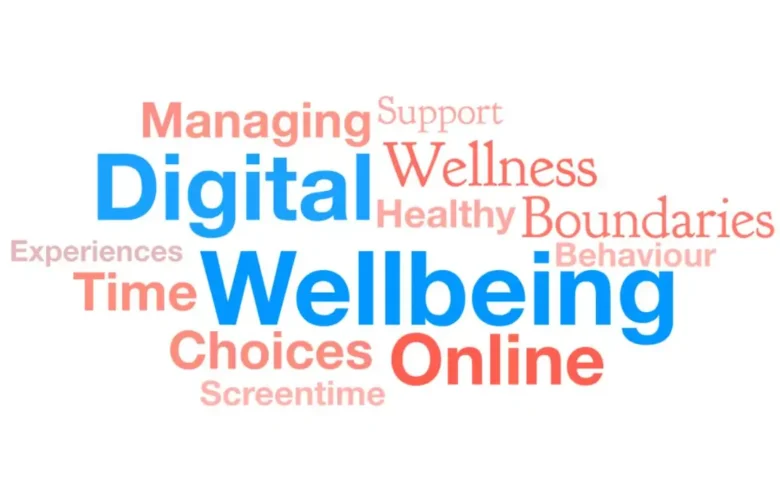Technology has changed the way we work, communicate, and live. Digital tools are convenient and connected, but excessive screen time and poor technology habits can harm our mental health, sleep, and well-being. Rather than giving up technology entirely, it’s better to develop thoughtful techniques to use it more mindfully. A balanced digital lifestyle requires awareness, boundaries, and continuous effort. This in-depth article covers everything from setting boundaries to creating technology-free zones to improve your digital well-being. This evidence-based approach empowers you to use technology while protecting your physical and mental health.
Understanding Digital Well-being:
A healthy and balanced relationship with technology allows us to use digital technology productively without harming our physical and mental health. This includes device use, time spent online, and how these activities impact our daily lives. Understanding digital well-being requires recognizing that technology should enrich our lives, not dominate them. Screen use has been linked to anxiety, sleep disturbances, and decreased social engagement. Digital well-being describes when, how, and why we consciously use technology to support our beliefs and goals.
Set Tech Boundaries:
Clear tech boundaries are essential for developing positive digital habits and preventing excessive technology use from disrupting other important aspects of your life. Limit screen time, such as no phone use during mealtimes and no screen time an hour before bed. Use built-in screen time limits or third-party apps to limit daily use of social media and entertainment apps. To avoid being on call 24/7, block off work time for checking emails and messages. Set phone-free times during family or personal time to prevent technology from disrupting valuable interactions. Create a digital life curve by charging electronics outside the bedroom and using a traditional alarm clock instead of your phone. These boundaries can create a routine and prevent technology from dominating your day.
Use Technology Responsibly:
Using technology mindfully requires considering how digital content can impact your mental health and productivity. Follow positive, educational, and inspiring social media accounts first and unfollow negative or comparison-seeking accounts. Before using a device, ask yourself why you need it and whether it aligns with your goals and needs. Choose quality digital messages over quantity and prioritize meaningful interactions over mindless browsing. Set technology goals, such as learning, connecting with friends, or working. Avoid information overload and anxiety by avoiding news and social media. Instead of multitasking, focus on technology to be productive and enjoy life.
Create a Technology-Free Zone:
Creating a technology-free space in your home can improve your digital well-being and foster peace and connection. Using electronic devices before bed disrupts your sleep and circadian rhythms, so the bedroom should be the first technology-free zone. Keep phones away from the dining room to promote mindful eating and meaningful interactions. Create a cozy reading nook or relaxation area for reading, journaling, or meditation. Store your phone in the trunk of your car or use a lockable phone holder for hands-free driving. Some families set up a technology-free space in the living room at certain times to encourage board games, conversations, and other screen-free activities.
Prioritize Face-to-Face Connections:
Digital communication and social media use can harm mental health by diminishing personal connections. Schedule regular personal time with friends and family to share meals, attend events, or simply chat. Put your electronics aside to show respect and enjoy time together. Instead of thinking about responses or digital distractions, actively listen during conversations. Join a local club, volunteer organization, or interest group to meet like-minded people and develop offline communities. Plan activities without technology, such as walking, cooking, and exercising. Digital communication can strengthen real-world relationships, but it can’t replace the depth and satisfaction they offer.
Fitness and Technology Use:
Besides eye strain, technology use can lead to posture problems, repetitive strain injuries, and reduced physical activity. To prevent neck and back pain, adjust the ergonomic position of your chair, monitor, and keyboard. Staring at an object 20 feet away for 20 seconds every 20 minutes can reduce eye strain. Move daily, especially while using the computer, to reduce muscle stiffness and improve circulation. To increase your physical activity, consider using a standing desk or having walking meetings. Avoid “text neck.” Hold your mobile device at eye level instead of staring at it. Keep your bedroom cool, dark, and away from devices that emit blue light for a good night’s sleep.
Technology Use and Mental Health:
How we use technology can impact our mental health both positively and negatively. Seeing the highlights of other people’s lives on social media can leave us feeling overwhelmed. Regular tech detoxes can reset your connection to technology and reduce anxiety and stress. Use meditation apps, online therapy platforms, and digital journals to improve your mental health, but don’t rely on them. Understand how different information affects your mood and energy, and avoid unpleasant messages, conflicts, and triggers. Use non-technological coping methods, such as exercise, creativity, and time in nature. If you suspect a tech addiction or your screen time is affecting your mental health, consult a mental health professional.
Parental Control:
It’s important for parents to set technology rules for their children and model healthy tech habits. Set clear limits on screen time, such as no phones during homework or family dinners. Please establish age-appropriate screen time limits and communicate them clearly to your children. Encourage your children to develop offline hobbies that foster creativity, physical fitness, and social skills. Be careful with your device around kids, as they tend to copy their parents’ actions over rules. Talk about online safety, digital citizenship, and respecting the online behavior of others. Use parental controls and monitoring tools appropriately, and encourage your children to self-regulate their digital device use. Family tech challenges or screen-free activities can help everyone develop positive habits.
Apps and Tools for Digital Well-Being:
Tools and apps can help you monitor and improve your digital well-being, but use them with caution and don’t add extra technology just to solve a technical problem. Smartphones and laptops with built-in screen time tracking can help you understand and improve your usage. Freedom, Cold Turkey, and RescueTime can prevent you from using distracting websites and apps while working.
Meditation apps like Headspace and Calm can improve your relationship with technology by fostering awareness. Blue-light filtering apps like f.lux and Night Shift can change your screen’s color temperature to reduce eye strain and improve your sleep. To avoid using electronic devices to perform basic tasks, consider using an analog alarm clock, paper planner, or watch. Use these tools temporarily to cultivate intrinsic motivation and healthy technology habits.
Creating Your Digital Future:
Developing healthy digital habits and achieving digital well-being requires patience, perseverance, and self-care. Balance your life with technology so it works for you, not controls you. Start with one or two of the strategies in this guide and build on your successes to achieve lasting change. Setbacks are normal, and progress may not happen overnight. Prioritize your physical and mental health, stay connected to the real world, and use technology with caution to protect your health while reaping its benefits. Be flexible, adapt to your needs and circumstances, and always prioritize your long-term health and well-being.
FAQs:
1. How much screen time do adults use?
There’s no universal rule for how much screen time adults should use, but experts recommend 2-3 hours per day outside of work. Purposeful screen time is better than aimless scrolling.
2. What are the symptoms of technology addiction?
Common symptoms of technology addiction include feeling anxious when away from technology, neglecting obligations or relationships due to excessive use, an inability to limit usage, and experiencing withdrawal symptoms. If these symptoms negatively impact your daily life, seek professional help.
3. How can you reduce blue light from screens?
Wear glasses with blue light filters, set your device to night mode, adjust your screen brightness based on your environment, and avoid screens for at least an hour before bed. Try using an app that adjusts the screen’s color temperature based on the time of day.
4. How do you develop a digital detox strategy?
Start with an hour or a day without devices and gradually increase your time. Choose activities to replace screen time, tell friends and family about your detox plan, and delete tempting apps. Focus on your strengths, not your weaknesses.
5. How do you maintain healthy technology habits while working remotely?
Adhere to clear work hours, create a separate workspace away from relaxation areas, take regular screen breaks, schedule time for focused work, and separate work and personal technology use.



